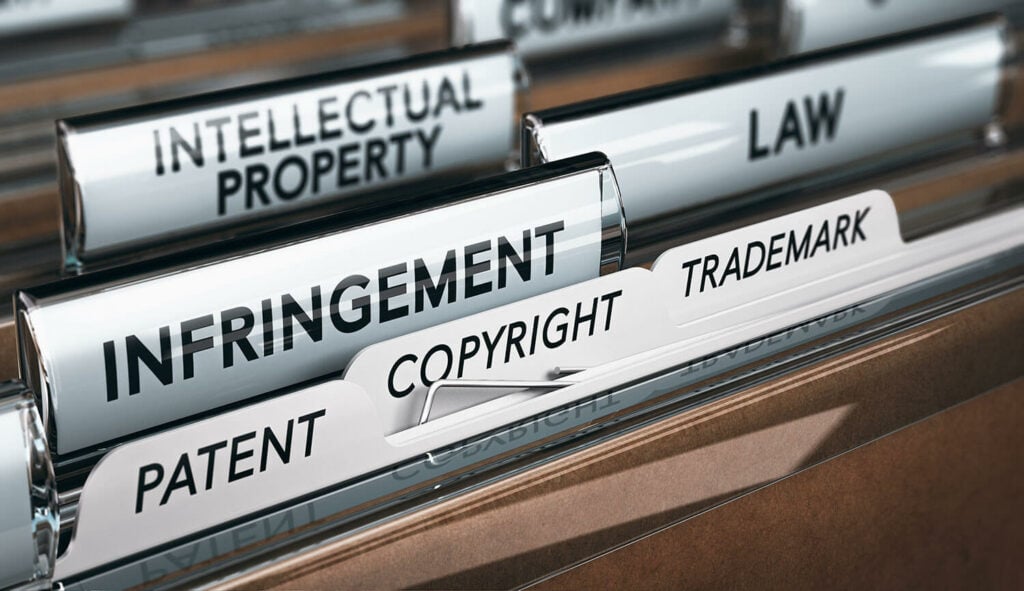The business of starting and running a company is one of most challenging, difficult, and rewarding undertakings a person can confront. The day-to-day effort required to design, produce, market, and sell a successful product or service leaves little time or energy for learning applicable law, especially a highly demanding and specialized area of the law like Intellectual Property (IP) Law. There are, however, some basic concepts that can clarify why IP protection adds significant valve to your company, especially in the eyes of investors.
The four most common forms of IP protection are patents, copyright, trademarks, and trade secrets. In this article, we take a closer look at three of them, patents, copyright, and trademarks. We will break down the differences between each and discuss how the use of one or more of them can provide your company with a sustainable competitive advantage.
The Difference Between Patents, Copyright, and Trademarks
Patents, trademarks, and copyrights are three different forms of IP protection that are distinct in many ways. For example, how they are acquired, what they protect, and how long that protection lasts. However, all three of these forms of IP protection provide their respective owners with the means to exclude others from profiting from the owners’ ideas or goodwill, while providing their owners with the ability to financially exploit their ideas and goodwill, either directly or through others. This right of exclusion can be tremendously valuable depending on how sought-after the product or service is.
Broadly speaking, a patent registration protects the right to make, use, sell, or import a tangible embodiment of a novel idea and not the idea itself. A trademark registration protects the identifier of a source of goods or services. A copyright registration protects the original creative tangible expression of an idea but not the idea itself.
Patents
A patent registration grants an exclusive right to the patent owner or licensee to exclude others from making, using, selling, or importing an invention. A patent brings value to your company and to society by encouraging innovation in exchange for a limited monopoly in exchange for publishing an enabling public disclosure of the invention. To elaborate, in exchange for disclosing how your invention is mad and/or operates, the government provides you with a limited term monopoly so that you can benefit financially from your inventtion without direct competition from others. However, when the monopoly term expires others are then free to exploit your invention. While a patent registration protects the owner of the patent it also protects and encourages investors in your company who recognize the value in the limited term monopoly on your innovation. A patent is not a right to use but does stops others from independently developing the invention.
There are three types of U.S. patents, utility, design, and plant, and by far and away the most common is the utility patent. Utility patents protect the way a product is constructed or how it works, design patents protect the appearance of a product, and plant patents protect asexually reproduced plants. A method, also called a process, is one of the four principal categories of things that may be protected through a utility patent. The other three being a machine, an article of manufacture, and a composition of matter. An invention must be useful, novel or new, and not an obvious variation of the existing prior art to be patentable. However, many new patents are improvement patents. These improvement patents build on existing technologies and are direct to an improvement to an existing product, process, and the like. The U.S. has joined most of the world in awarding patents on a first-to-file basis. Therefore, an inventor should try an obtain the earliest possible filing date to protect their invention, preferably before any public disclosure of the invention.
The term of a utility patent is 20 years measured from the earliest effective U.S. filing date. Full legal protection, that is the exclusive right to exclude others from making, using, or importing the invention, is only available to the patent owner after the patent has issued, which in many cases may be about 30 months after the U.S. filing. However, a patent owner may have provisional rights to recover a reasonable royalty accruing from the time when the patent application is published, normally 18 months after filing date, and the time the patent issued. This is predicated on the fact that any infringer received actual notice of the published patent application (e.g., through a cease and desist letter).
A design patent provides its owner with a monopoly on the distinctive appearance of an article of manufacture. A design patent must be novel, non-obvious, and purely ornamental. That is, a design patent cannot cover, and therefore protect functional aspects of an article of manufacture. Instead, it is limited purely to the subject item’s non-functional appearance aspects. The term of a design patent is 15 years from the date of issue.
What Are the Advantages of a Patent?
While patents are generally more expensive than other forms of IP protection, they confer to their owners a substantial competitive advantage. Patents are particularly important to start-ups who compete for investor dollars because investors see the ownership of IP as one of the ways they can receive a return on their investment, even if the start-up should eventually fail. Patents are also a marketing tool and to many consumers convey the impression of a superior technology and product(s). Patents block competitors and make it more difficult for them to encroach on your business space in the future, especially as issued patents can be prohibitively expensive to challenge for many firms. Patents can also open the door to additional streams of revenue because patents can be licensed and sold. Patents add value to a company during mergers and acquisitions. Patents protect a company’s R&D and marketing investment while the company is developing new products and services. Lastly, patent applicants can use “Patent Pending” (sometimes shortened to “Pat. Pend.”) on their product to show that a patent application has been filed with USPTO and is in the process being examined. This designation can discourage competitors and generate interest in many cases.
Trademarks
Fundamentally a trademark indicates the source of a product or service to the buying public. The test that the Trademark Office uses to determine whether a company is entitled to a Trademark is to determine whether the buying public associates the trademark with the company. People often use the word brand in the place of trademark but there is a difference between the two terms. On one hand, a trademark is a word, phrase, graphical image (logo), or combination thereof and can also take the form of a a name, symbol, design, image, or a combination of these elements that the buying public associates with a particular company. On the other hand, a brand can be through of as the collective impact or lasting impression from all that is seen, heard, or experienced by members of the buying public who have encounter your company and its products and services.
A trademark indicates to the buying public who is the source of the product or service and distinguishes a company and its products in the marketplace. A trademark forms part of the company’s brands, and a brand is intimately related to the company’s reputation. In turn, this allows the company to establish a price premium for its products and services over those of its competitors.
A common law trademark is a trademark established solely through use in commerce in a specific geographical area and is indicated by the trademark symbol ™ or, in the case of a service mark, the service mark symbol SM. A registered trademark is indicated by the ® symbol. To obtain a registered trademark a trademark registration must be submitted and reviewed by the United States Patent and Trademark Office (USPTO). One of the requirements of trademark registration is that the trademark must be used in commerce to indicate the source of the goods for sale or services being offered. However, the trademark can be reserved for a period of time pending its use in commerce with the filing of an Intent to Use statement with the USPTO at the time of registration. A registered trademark has federal protection, which grants the ability to bring legal action in a federal court for trademark infringement, and the ability to file with U.S. customs to prevent fake goods coming into the country.
Unlike patents and copyrights, trademarks do not expire so long as the owner continues to use the trademark in commerce to identify the source of goods for sale or services being offered. If federally registered, the owner also must periodically renew the mark.
What Are the Advantages of a Trademark?
A federal trademark allows the registrant/owner to stop copycats, helps build a powerful brand, and makes it easier to sue those who steal or attempt profit from your mark’s goodwill and your reputation. A powerful brand allows the owner to charge more in the marketplace for what is perceived to be a premium and desirable product or service by the buying public. A federal trademark provides the owner with national protection and the ability to file a civil action in state and federal courts for infringement. Trademarks add value to a company during mergers and acquisitions.
Copyrights
Copyright registration gives the owner of the copyright the exclusive right to authorize others to reproduce the work, make derivative works, distribute the work, sell copies of the work, and display the work in public. While authorship captured in a tangible medium establishes copyright prima facie (by presumption unless disproved or rebutted), registration of a copyright secures legal standing and gives the owner the ability to recover damages in the event of copyright infringement.
Copyright registration protects the original, creative expression (work product) of an idea by artists, authors, and the like when fixed in a tangible form. Copyrights do not protect book and song titles, short phrases, real-world events, ideas, themes, or plot lines. Copyright protection provides the owner of the copyright with the exclusive right to reproduce the work, distribute or sell copies, create derivative works, publish, perform, and display the work. The work can be artistic, dramatic, literary, written words, musical, poetry, architecture, computer software, novels, movies, songs, graffiti, websites, and the like.
Copyright protection originates when any original and creative work is fixed in a tangible medium. However, if the work is vital to a business, or likely to be copied, it is important to register the work with the U.S. Copyright Office, not least because registration is a requirement before an infringement action can be brought. While it’s advisable to mark both unregistered and registered copyright works with the © symbol, it is particularly important with registered works because of the possibility of a larger financial reward in any infringement action. Broadly speaking, the term of the copyright is life of the author plus 70 years.
What Are the Advantages of Copyright?
Registration of a copyright secures legal standing and the ability to recover damages in the event of a copyright infringement action. Registration is a requirement for certain damages awards in an infringement action.
Take Our Intelligent IP Quiz To Find Out What Type of Protection May Be The Best Fit for You
An experienced intellectual property attorney can help you not only secure a copyright, patent, or trademark but also advise you on which type of protection is best suited to your business’s needs. Lastly, while this article highlights some of the differences between patents, copyright, and trademarks, and these areas of IP do not overlap, this is not always the case. For example, it is possible to secure both copyright and a utility patent on a software code/process, a design patent and a trademark on an ornamental feature of an object, and the like.
The Rapacke Law Group is a business and intellectual property law firm built for the speed of startups. We offer startup, business, and intellectual property legal services for a transparent flat fee with no hourly billing and no charges for calls or emails.
Our experience ranges from helping startups in their infancy to advising established businesses regarding regulatory and intellectual property matters. Our lawyers have experience assisting fast-moving, entrepreneurial companies seeking legal counsel in company formation agreements, liability, equity issuance, venture financing, IP asset protection, IP infringement resolution, and IP litigation.
Contact us today and let us help you protect your business with a patent, trademark, or copyright.
Take Our Intelligent IP Quiz To Find Out What Type of Protection May Be the Best Fit for You.




